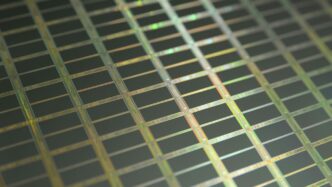WIN Semiconductors is a company that makes chips. You know, those tiny things that make all our gadgets work? Well, they’re a big deal in that world. This article is going to look at what makes WIN Semiconductors tick, where they stand in the market, and what they’re doing to stay ahead. It’s a pretty complex industry, so we’ll try to break it down in a way that makes sense.
Key Takeaways
- WIN Semiconductors operates within a global semiconductor market that’s always changing, facing competition from all sides.
- The company focuses on specific areas of the market where its chips are really needed, like in certain types of electronics.
- WIN Semiconductors puts money into research and development to come up with new technologies and manufacturing methods.
- They play a role in the bigger picture of making chips, working with other companies that design them but don’t make them.
- Looking ahead, WIN Semiconductors is thinking about new technologies and how to grow its production to keep its edge.
Understanding WIN Semiconductors’ Market Position
The Evolving Global Semiconductor Landscape
The world of semiconductors is always shifting, and it’s a pretty big deal for pretty much everything electronic we use. Think about it: from your phone to your car, chips are the brains. The global market is huge, with different countries and companies all trying to get a piece of the action. For a long time, the US was the big player, inventing the whole thing with things like the transistor and the integrated circuit. But over the years, other places like Taiwan, South Korea, and even China have become major forces, especially in manufacturing.
It’s not just about making chips, though. There’s a whole chain involved: designing them, making the special machines to build them, and then actually fabricating the chips themselves. The US is still really strong in design, but manufacturing has moved around a lot. Countries like Japan used to be huge in this space but struggled to keep up with the rapid changes. Now, companies like TSMC in Taiwan are giants, producing a massive amount of the world’s chips, including the really advanced ones. This global picture is constantly changing, with new technologies and market demands popping up all the time.
WIN Semiconductors in the Context of Global Competition
When you look at WIN Semiconductors, you have to see it against this backdrop of intense global competition. It’s not like they’re operating in a vacuum. They’re up against some really established players, especially in areas like chip manufacturing. While some countries are pouring billions into developing their own chip industries, like China has been trying to do, the results are mixed. Some reports suggest that even with all that investment, certain Chinese chipmakers are still a few generations behind the leaders in manufacturing cutting-edge chips. It’s a tough race, and staying ahead requires constant innovation and smart business moves.
WIN Semiconductors needs to find its niche and excel within it to stand out. This means understanding where the market is heading and where their strengths lie. Are they focusing on specific types of chips? Are they competing on cost, performance, or specialized technology? The semiconductor industry is complex, with different segments like logic chips, memory chips, and analog chips, each with its own set of challenges and opportunities. Being a successful player means having a clear strategy for how to compete effectively in this dynamic global arena.
Key Market Segments for WIN Semiconductors
To really understand where WIN Semiconductors fits in, we need to look at the specific markets they serve. The semiconductor industry isn’t one big blob; it’s broken down into several key areas, and companies often specialize. Some of the major segments include:
- Logic Chips: These are the "brains" of most electronic devices, handling calculations and decision-making. Think processors for computers and smartphones.
- Memory Chips: These store data. This includes DRAM (used for active data) and NAND flash (used for long-term storage like in SSDs).
- Analog Chips: These deal with real-world signals, like sound or temperature, converting them into digital information that processors can understand, and vice-versa. They’re important for things like sensors and power management.
- RF (Radio Frequency) Chips: These are used in wireless communication devices, like Wi-Fi chips, Bluetooth modules, and cellular modems.
WIN Semiconductors likely focuses on one or more of these areas, or perhaps a combination. Their success depends on how well they can meet the demands of these specific markets. For instance, the demand for advanced RF chips is growing rapidly with the rollout of 5G and future wireless technologies. Similarly, the need for specialized analog chips is increasing as more devices become "smart" and need to interact with their environment. Identifying and dominating these key segments is vital for their market position.
Innovation Drivers at WIN Semiconductors
WIN Semiconductors isn’t just building chips; they’re actively pushing the boundaries of what’s possible in semiconductor technology. This drive comes from a few key areas that keep them ahead of the curve.
Research and Development Investments
It’s no secret that staying competitive in the chip world means pouring money into R&D. WIN Semiconductors dedicates significant resources to exploring new materials, refining manufacturing processes, and developing next-generation chip designs. This isn’t just about incremental improvements; it’s about making big leaps. Their commitment to R&D is the bedrock upon which their technological advancements are built. They understand that the future of electronics depends on the innovations happening in labs today.
Technological Advancements in Chip Manufacturing
When we talk about chip manufacturing, it’s a complex dance of physics and engineering. WIN Semiconductors is at the forefront of adopting and developing advanced techniques. This includes:
- Process Node Shrinkage: Continuously working to make transistors smaller and more efficient, which is key for packing more power into smaller devices.
- New Material Integration: Exploring and implementing novel materials beyond traditional silicon to improve performance and power efficiency.
- Advanced Packaging: Developing sophisticated ways to connect and protect chips, which is becoming just as important as the chip itself.
- Yield Improvement: Implementing sophisticated quality control and process optimization to ensure a high percentage of functional chips from each wafer.
Intellectual Property and Patent Strategies
Protecting their innovations is just as important as creating them. WIN Semiconductors actively pursues patents for their unique technologies and manufacturing methods. This not only safeguards their competitive edge but also signals their commitment to innovation to the wider industry. A strong patent portfolio can be a significant asset, allowing them to license their technology and collaborate with partners from a position of strength. It’s a strategic move that helps secure their place in the market for years to come.
WIN Semiconductors’ Role in the Supply Chain
Foundry Services and Manufacturing Capabilities
WIN Semiconductors operates as a key player in the semiconductor supply chain, primarily functioning as a foundry. This means they specialize in manufacturing chips designed by other companies, often referred to as fabless firms. Think of it like a custom bakery; clients bring their recipes (chip designs), and WIN Semiconductors has the ovens and skilled bakers (manufacturing facilities and expertise) to bring those recipes to life. Their manufacturing capabilities are the backbone of their contribution, allowing for the production of complex integrated circuits that power everything from smartphones to advanced computing systems. The precision and scale of these operations are what allow for the mass production of the tiny, intricate components that define modern electronics.
Collaboration with Fabless Companies
Much of WIN Semiconductors’ business revolves around working closely with fabless semiconductor companies. These companies focus on chip design and marketing but don’t own their own manufacturing plants. This symbiotic relationship is vital for the industry. WIN Semiconductors provides the essential manufacturing infrastructure, allowing these fabless innovators to bring their cutting-edge designs to market without the massive capital investment required for a fabrication facility. This collaboration speeds up the innovation cycle, as designers can focus on what they do best, knowing they have a reliable manufacturing partner.
Contribution to Advanced Semiconductor Nodes
WIN Semiconductors is involved in producing chips at various technology nodes, which essentially refers to the size of the transistors on the chip. Smaller nodes mean more transistors can fit into the same space, leading to faster, more power-efficient chips. While the absolute leading edge might be dominated by a few giants, WIN Semiconductors plays a significant role in enabling the production of chips at advanced nodes that are critical for many applications. Their ability to manufacture at these sophisticated levels supports the development of next-generation products across numerous sectors.
Here’s a look at some general areas where foundries like WIN Semiconductors contribute:
- Enabling Innovation: Providing the manufacturing muscle for new chip designs that might otherwise never see the light of day.
- Scaling Production: Taking designs from prototypes to mass-market volumes.
- Specialized Manufacturing: Offering expertise in specific types of chip production, like those for high-frequency applications or power management.
- Supply Chain Resilience: Acting as a reliable source for critical components, helping to diversify manufacturing options.
Strategic Partnerships and Ecosystem Engagement
WIN Semiconductors doesn’t operate in a vacuum. Building strong relationships is key to staying ahead in the fast-paced semiconductor world. They actively work with others to push technology forward and make sure their place in the market stays solid.
Industry Collaborations for Technological Progress
Think of it like a team sport. WIN Semiconductors partners with other companies, both big and small, to share ideas and resources. This helps them tackle complex challenges that one company might not be able to solve alone. For instance, working with chip designers means WIN can get early insights into what new types of chips will be needed, allowing them to prepare their manufacturing processes. These collaborations are vital for developing the next generation of semiconductor technology. It’s all about pooling brainpower and manufacturing might.
Academic Partnerships and Talent Development
Keeping up with the latest science and finding smart people to work with is a big deal. WIN Semiconductors connects with universities and research institutions. This isn’t just about getting new ideas; it’s also about training the next wave of engineers and technicians. They might sponsor research projects or offer internships. This helps ensure a steady flow of skilled workers who understand the cutting edge of chip making. It’s a two-way street: the academics get real-world problems to solve, and WIN gets access to fresh talent and innovative thinking.
Navigating International Trade and Regulations
The semiconductor industry is global, and that means dealing with different countries, rules, and trade agreements. WIN Semiconductors has to pay close attention to these things. They work to understand trade policies and how they might affect their business, like getting materials or selling their products. Sometimes, this involves working with industry groups to make sure trade rules are fair and support innovation. It’s a complex dance, but staying on top of international trade is just part of the game for a company like WIN. Understanding the global semiconductor landscape is key here Semiconductors are essential components.
Here’s a look at some areas where partnerships are important:
- Research & Development: Joint projects with other firms or universities to explore new materials or manufacturing techniques.
- Supply Chain Security: Collaborating with suppliers and customers to build a more resilient and predictable supply chain.
- Standards Development: Participating in industry groups to help set standards for new technologies, which can speed up adoption.
- Workforce Training: Partnering with educational institutions to develop curricula that meet the industry’s evolving needs.
Future Outlook for WIN Semiconductors
Emerging Technologies and Market Trends
Looking ahead, WIN Semiconductors is positioned to ride the wave of several big tech shifts. Think about the massive growth in AI, the push for more connected devices (IoT), and the constant demand for faster, more efficient communication technologies like 5G and beyond. These aren’t just buzzwords; they’re driving a real need for advanced semiconductor components. WIN’s focus on compound semiconductors, particularly Gallium Arsenide (GaAs) and Gallium Nitride (GaN), puts them right in the sweet spot for many of these applications. For instance, GaN is becoming super important for power electronics – think electric vehicles and efficient power supplies – and for high-frequency applications in 5G infrastructure. WIN’s ability to innovate in these specific material sciences will be key to staying ahead. The market for these specialized chips is growing, and WIN seems ready to capture a good chunk of it.
Expansion Plans and Capacity Growth
To keep up with demand, WIN Semiconductors is likely looking at expanding its manufacturing capabilities. This isn’t just about building more cleanrooms; it’s about investing in the right equipment and processes to handle the next generation of chip designs. We’re talking about scaling up production for their core technologies while also exploring new ones. It’s a balancing act, for sure. You don’t want to overspend, but you definitely can’t afford to miss out on market opportunities because you don’t have enough capacity. Expect to see strategic investments in new facilities or upgrades to existing ones, all aimed at boosting output and efficiency. This growth needs to be smart, though, focusing on areas where WIN has a clear advantage.
Sustaining Competitive Advantage in WIN Semiconductors
So, how does a company like WIN Semiconductors keep its edge? It’s a mix of things. First, continued investment in R&D is non-negotiable. They need to keep pushing the boundaries of what’s possible with compound semiconductors. Second, building strong relationships with customers is vital. Understanding what designers need for their next-gen products allows WIN to tailor its manufacturing processes and even co-develop solutions. Finally, staying agile in a rapidly changing global market is crucial. This means keeping an eye on geopolitical shifts, supply chain dynamics, and the competitive landscape. It’s not just about making good chips; it’s about making the right chips at the right time and getting them to the people who need them, all while keeping an eye on costs and quality. It’s a complex puzzle, but WIN seems to have a good handle on the pieces.
Wrapping Things Up
So, looking at WIN Semiconductors, it’s clear they’re a pretty big deal in the chip world. They’ve managed to carve out a significant spot for themselves, especially when you consider how tough this industry is. While they might not always be the first to roll out the absolute newest tech, they’re definitely holding their own and making smart moves. It’s interesting to see how they fit into the bigger picture, especially with all the global competition and the constant push for better, faster chips. They’re a company worth keeping an eye on as things keep changing so fast in the tech landscape.
Frequently Asked Questions
What does WIN Semiconductors do?
WIN Semiconductors is a company that makes special computer chips. Think of them like the brains for electronic devices. They are really good at making these chips for things like phones, computers, and other gadgets.
How is WIN Semiconductors doing compared to other chip companies?
WIN Semiconductors is a big player in the chip world, especially for certain types of chips used in wireless technology. They work with many different companies to create the chips that go into our everyday electronics. They are known for being a reliable maker of these important parts.
What makes WIN Semiconductors innovative?
The company spends a lot of money on new ideas and research. They are always trying to find better ways to make chips, using the latest technology and machines. They also protect their unique chip designs with patents, which is like a special badge for their inventions.
How does WIN Semiconductors help other companies?
WIN Semiconductors acts like a factory for companies that design chips but don’t make them themselves. These ‘fabless’ companies come to WIN to have their chip designs actually built. This partnership helps bring new electronic products to life faster.
What are the future plans for WIN Semiconductors?
WIN Semiconductors is looking ahead to new technologies and what people will want in the future. They are planning to build more factories and improve their technology so they can keep making the best chips for upcoming gadgets and trends.
Why are semiconductors important?
Semiconductors, or chips, are super important because they are in almost every electronic device we use. They help our phones, computers, cars, and even medical equipment work. Without them, the modern world wouldn’t be able to function the way it does.












